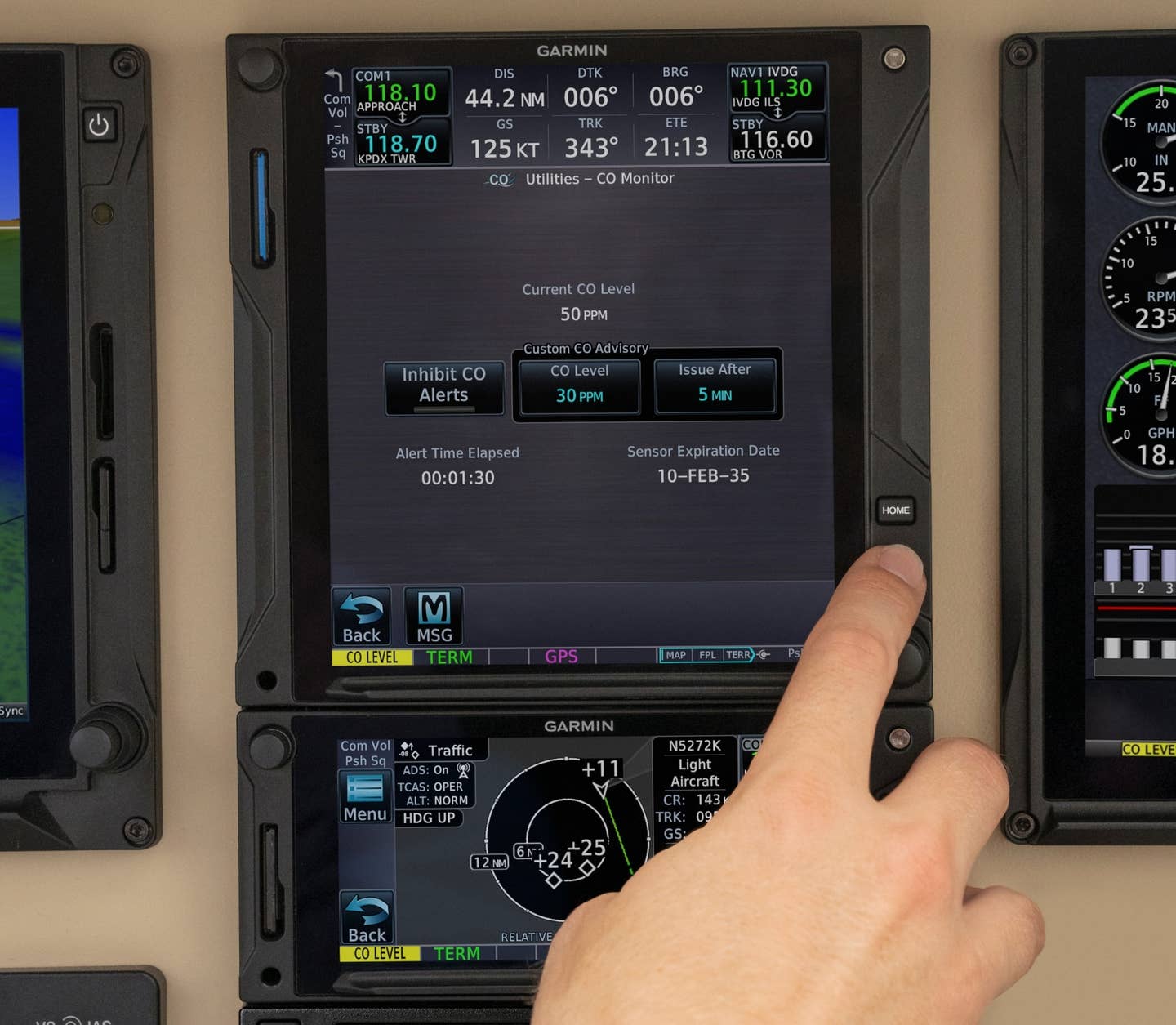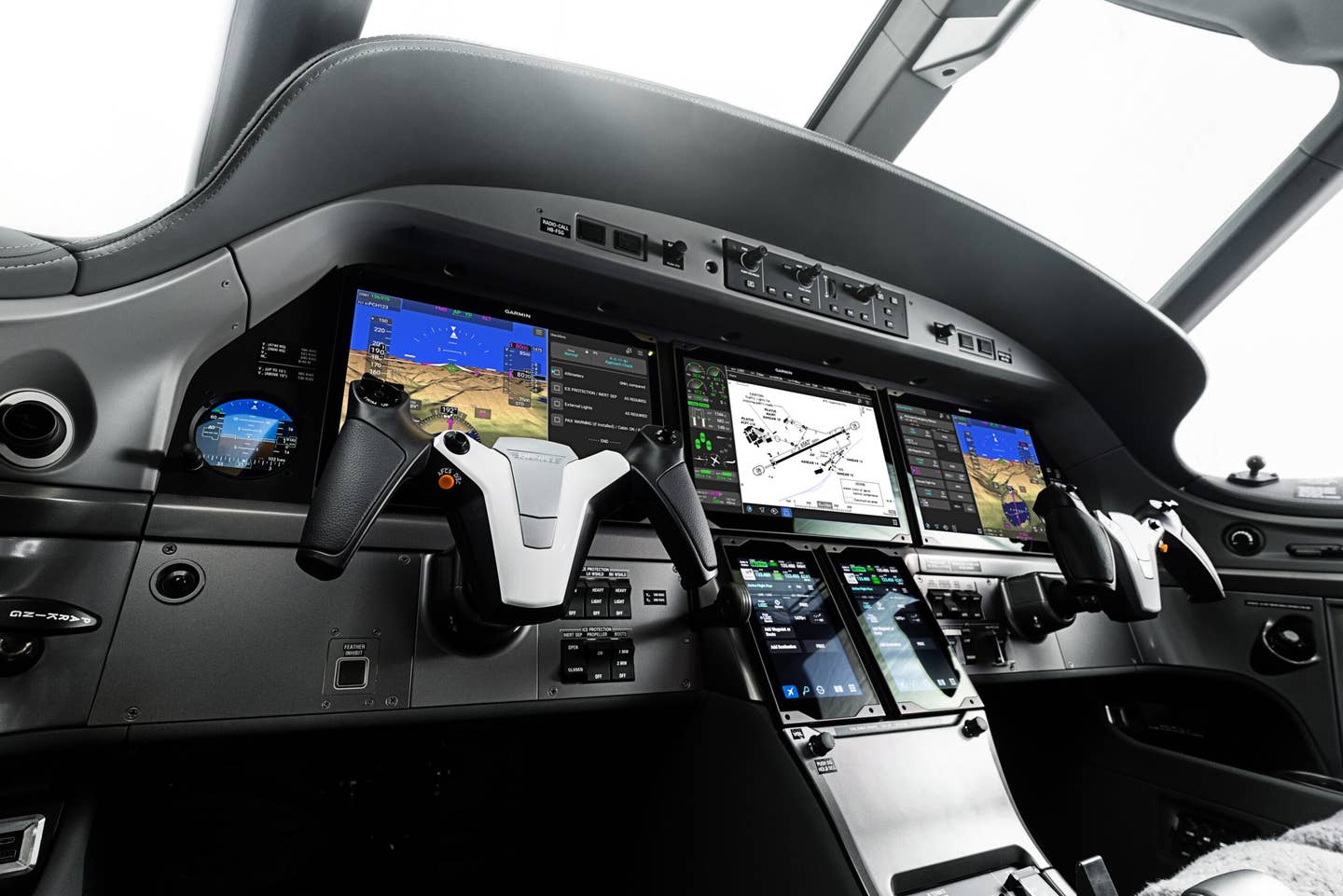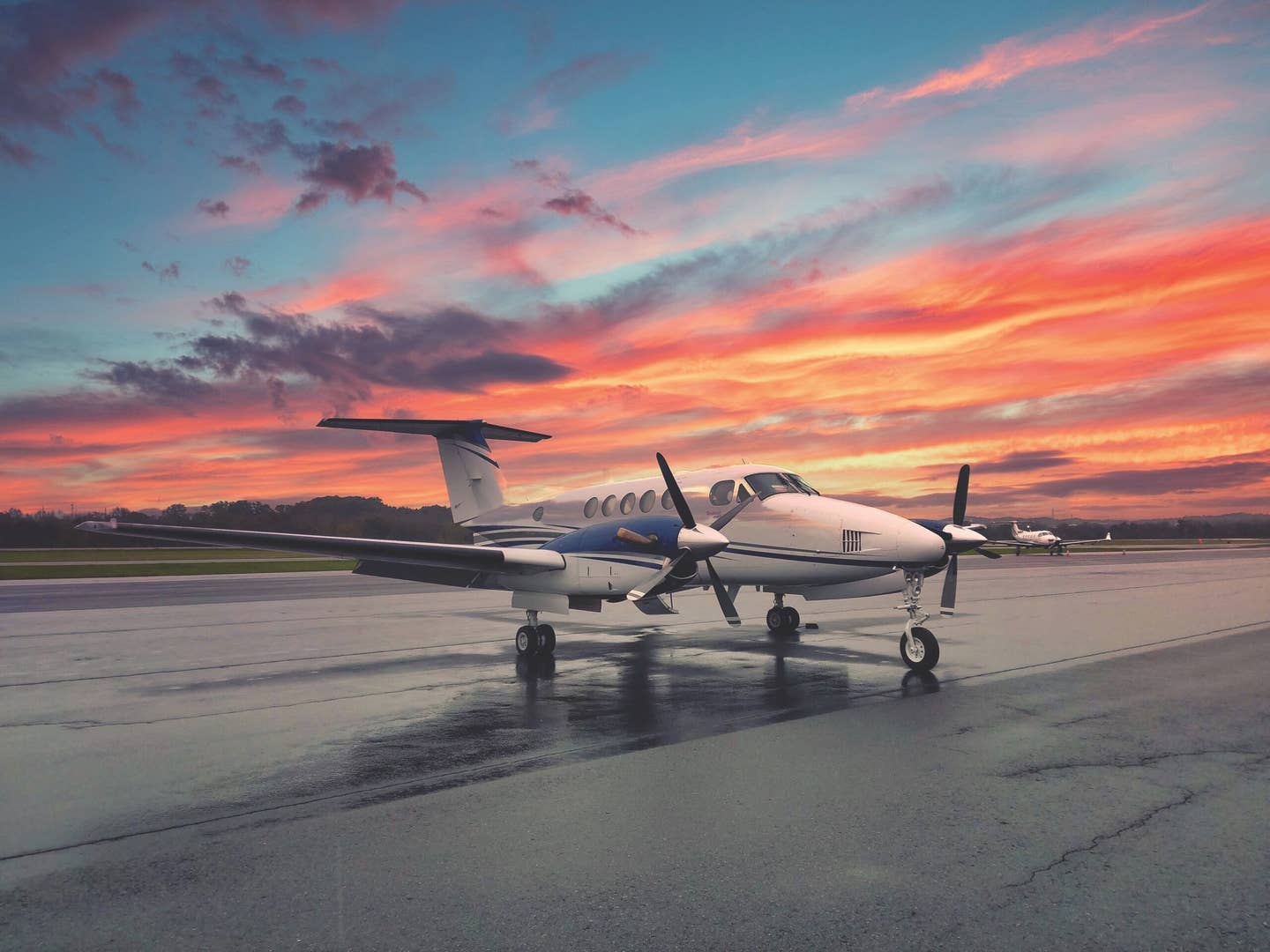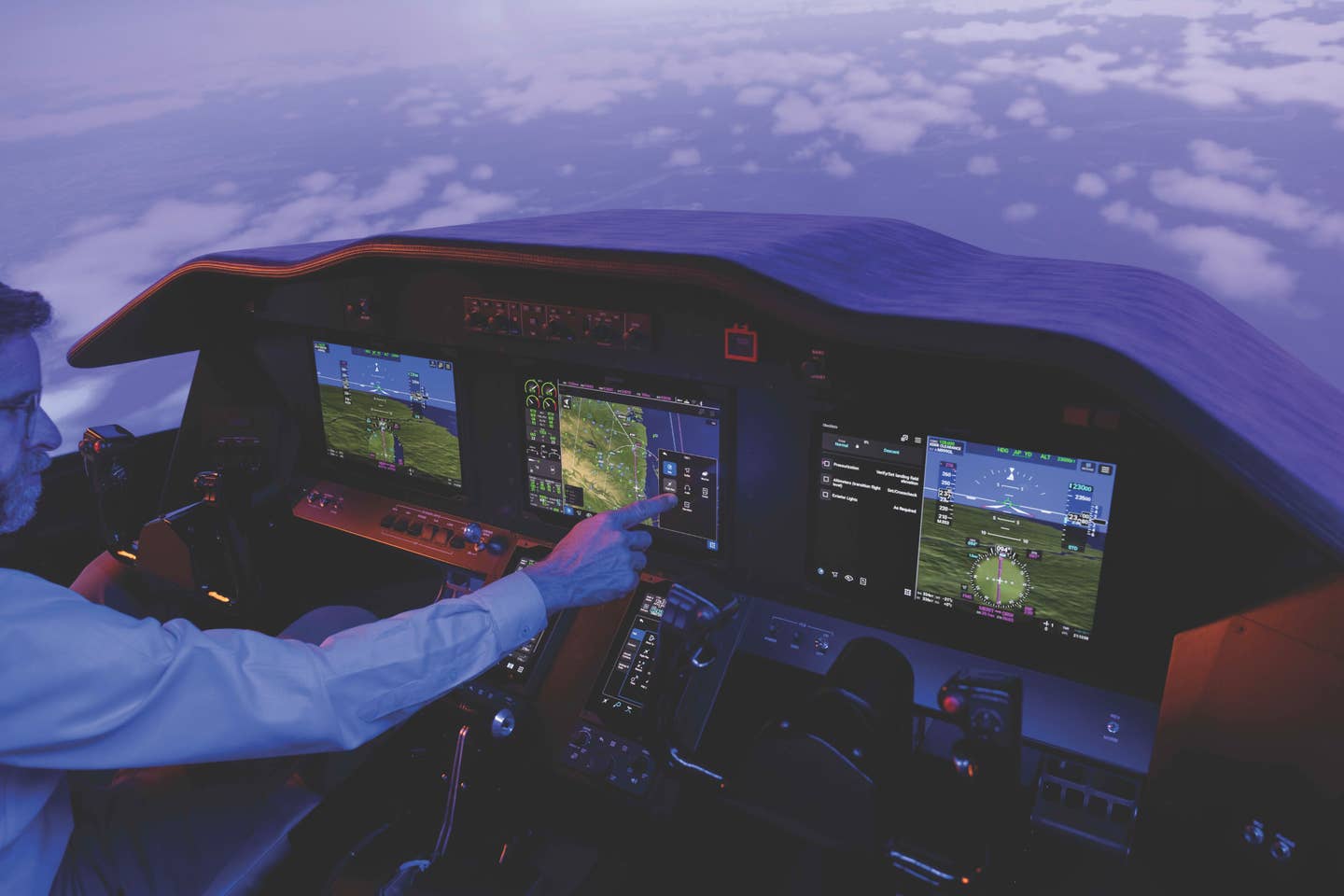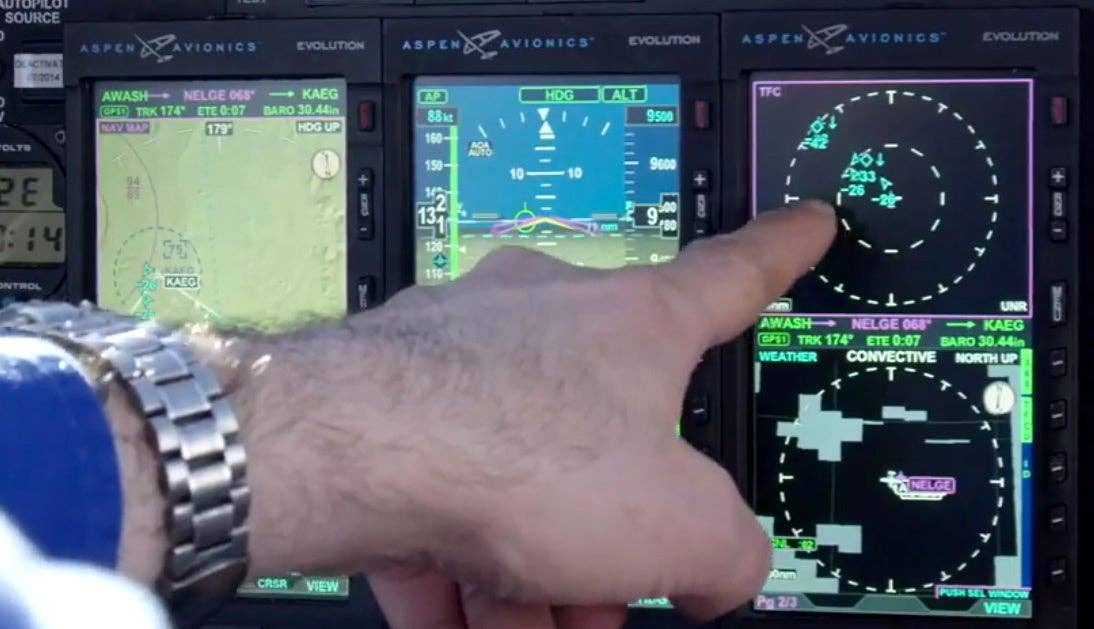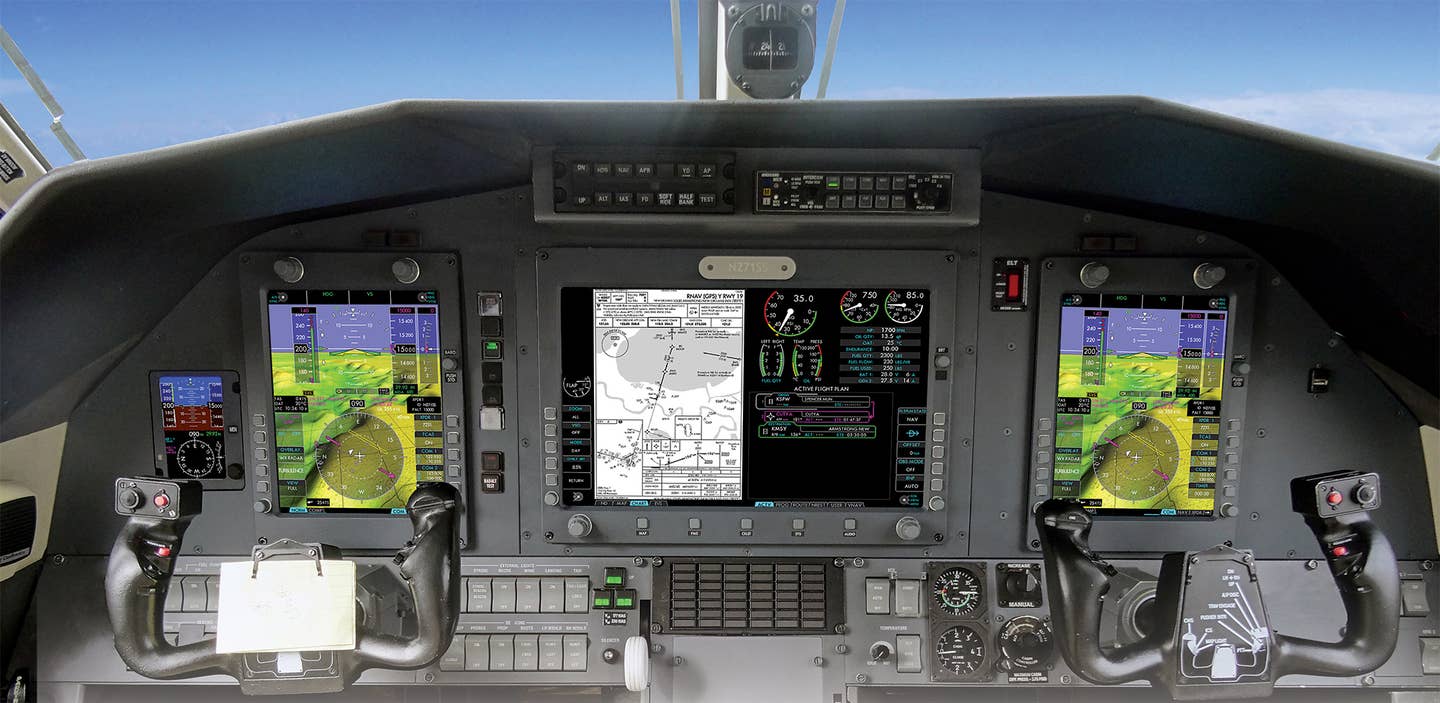
What is this voodoo? I’d been glancing outside the airplane, a last check for traffic on short final, as Eric Smedberg, chief pilot for Innovative Solutions & Support, swung the Pilatus PC-12 onto the runway and engaged the autothrottle system with a simple press of a button. I looked down just in time to see the power lever advancing from the idle position to max continuous takeoff thrust, which on this day was a little more than halfway to the forward stops. Seeing the autothrottles in action on a business jet or airliner is no big deal, but in a PC-12 powered by a Pratt & Whitney PT6A lacking full-authority digital engine control, that lever shouldn’t move by itself. It was like a ghost was in our presence — a decidedly friendly ghost, I had to admit.
For nearly the next two hours of flying, including climbs, cruise flight, descents and required navigation performance (RNP) precision instrument approaches, neither Smedberg nor I adjusted the power lever or touched the yokes. Occasional button pressing and knob twisting, plus radio calls and the requisite scans for traffic on this VFR day, were about the only duties necessary for the human pilots on the round-robin demonstration flight across central New Jersey. It wasn’t until we were on final approach for landing back at Morristown Municipal Airport that Smedberg clicked off the autothrottle at 500 feet and took manual control from the unseen computerized apparition that had been working furiously — and flawlessly, I must report — behind the scenes to keep us perfectly on speed, course and altitude throughout our time aloft.
Autothrottle is the last remaining piece of the automation puzzle that can extend the full complement of safety benefits, including flight-envelope protection, to general aviation airplanes, where single-pilot operations put a special emphasis on the need for workload reduction — especially in busy airspace such as we found ourselves. Jet airliners have had rudimentary auto-thrust capability since the 1950s, of course, starting with the Boeing 707. Today, automatic speed control is taken almost for granted in modern business jets and airliners. But the adoption of autothrottle technology in smaller GA airplanes has been slow to evolve, owing mainly to the fact that the mechanical systems required to create an autothrottle system have traditionally been so big and unwieldy that they could fit only in the largest airplanes.
That’s all changing. Just as computer electronics have shrunk in size over the decades, the components needed to bring autothrottle to an airplane like the PC-12 can now fit in the tight confines of the cockpit, and equally as important, they can be had for prices that make a retrofit installation feasible. IS&S, a small but highly competent avionics manufacturer based in Exton, Pennsylvania, calls its technology ThrustSense. It’s part of a complete NextGen avionics retrofit that’s certified and available now for the PC-12 and coming to other turboprops soon, beginning with the King Air family. The full retrofit can include new glass displays, WAAS GPS receivers, radios and more, or a buyer can choose to add only the autothrottle components.

Advanced Features
ThrustSense offers much more than mere airspeed control, as I soon realized as we climbed out from Morristown’s Runway 23 with the system set in its torque-hold mode. The autothrottle automatically reduced power from takeoff to climb setting at the appropriate time interval, ensuring the engine remained within normal operating parameters without the pilots even having to think about it. As soon as the takeoff/go-around button is pressed on the runway, the autothrottle enters go-around mode and places the flight director command bars at 7.5 degrees pitch up. Once airborne, the system transitions to “AT Climb” mode and the autothrottle pulls back the power gradually to remain within temperature and torque limits. “AT TRQ” mode lets the pilot adjust torque value to permit the engine to run at an easy gallop.
Before departure, we’d set up a route that would eventually take us into New Jersey’s Trenton-Mercer Airport, where we’d execute the continuous descent RNP approach to Runway 24. The procedure involves a curved path to the runway, with mandatory speed restrictions along the way. As I studied the approach chart on the MFD, it quickly became evident that this would be a difficult procedure to fly properly without automation. But with the approach loaded into the IS&S FMS and ThrustSense performing its magic, the procedure was a thing of beauty as the PC-12 flawlessly executed a gently descending 180-degree turn that kept us exactly on the preprogrammed track, and at the altitudes and the speeds we needed to hit, as Smedberg and I smugly sat in our respective pilot seats monitoring the system’s action. As I sat with my hands in my lap and observed the automation in action, I couldn’t help but be impressed.
"Fadec-like" Control
At its core, ThrustSense consists of electromechanical components that control power output to the engine through IS&S’s integrated standby unit (ISU)/control panel, a small backup EFIS that runs all the software needed to control virtually any Pratt & Whitney PT6A turbine engine. Smedberg explained that the ISU’s software provides “fadec-like” engine protection that provides the automatic torque control, as well as traditional airspeed hold when that mode is selected, plus over- and under-speed protection and takeoff/go-around mode that automatically advances the power when the TOGA button on the thrust lever is pushed while executing a missed approach.
Owing to IS&S’s extensive experience in military retrofit programs, the technology adds a slew of additional features that I wasn’t expecting to find in an aftermarket autothrottle priced at $55,000, before the cost of installation. For instance, over-temperature protection built into ThrustSense monitors interstage turbine temperature (ITT) and continually adjusts the power to ensure normal operating parameters are never exceeded. In addition, a turbulence penetration speed protection mode can be selected through the ISU, as well as automatic power setting for maximum range or endurance, a requirement in military applications. And, of course, the fact that the technology, when paired with the IS&S NextGen retrofit cockpit, can fly a full RNP procedure, maintaining all speed restrictions with the pilots never having to touch the thrust lever, makes ThrustSense a boon for pilot workload reduction.
For owners of older PC-12s with the original Honeywell cockpit incorporating a mix of displays and electromechanical instruments, the upgrade to IS&S full NextGen 3015 cockpit can make sound operational sense by providing maximum flexibility and access to 21st-century airspace tools, not to mention it cuts about 60 pounds of weight. For an additional $300,000, the retrofit involves removing the Honeywell gear and updating the cockpit with left and right 10.4-inch portrait displays with optional synthetic vision and a central 15.4-inch landscape multifunction display. The cockpit makeover includes full ADS-B In and Out capability, VNAV for en route descents, the RNP approach navigation, LPV approach guidance, electronic charts and more.
The system’s data concentrator units communicate with the PC-12’s original BendixKing KFC325 autopilot as well as the weather radar, TAWS, traffic warning system and SiriusXM weather receiver, plus new IS&S engine data concentrators and other components. Additional equipment includes a pair of WAAS GPS receivers, dual flight management systems, and options for upgraded ADAHRS and an oil quantity sensor. In addition, the original radios are replaced with new multimode radios, L-3 NGT9000R ADS-B transponder and dual digital air-data computers.
For those unfamiliar with IS&S, the company has been an avionics supplier to business aviation, the air transport market and the military for decades, building a reputation for quality products offered at reasonable prices. IS&S developed the original Avio cockpit for the Eclipse jet. It is perhaps best known for its state-of-the-art Boeing 757/767 cockpit retrofit designed to bring the aging airliner up to the most current NextGen operating standards. The company was founded in 1988 by Geoffrey Hedrick, an engineer, entrepreneur and pilot who embarked on the autothrottle development project out of his own self-interest. He owned and flew a PC-12 and wanted an autothrottle for it. Since none existed, he directed his engineering team to go out and build one.
The first challenge was in designing an electronic and completely clutch-less autothrottle that could be adapted to a variety of business turboprops. Space, obviously, was the biggest constraint in the PC-12. Autothrottles on Pratt & Whitney PT6A-powered single-engine turboprops are unusual because they normally require clutches and motors, which take up a lot of space in the throttle quadrant, room that simply isn’t available in the PC-12. It’s also unusual to find autothrottle technology mated to an engine lacking fadec. The PT6A uses traditional hydromechanical engine controls, and yet the IS&S autothrottle still manages to protect the engine from over-torquing and over-temping through the ingenious use of its computer software.
Smedberg says the autothrottle can be adapted to virtually any PT6A-powered airplane by adding the ISU standby display, which operates the thrust computer software that makes the autothrottle function. Testing of ThrustSense aboard a King Air 200 is well underway. IS&S and Blackhawk Modifications have already announced an agreement for Blackhawk to distribute and install IS&S’s NextGen flight deck and integrated turboprop autothrottle system for King Air 200s and 350s — and for good reason. The two models account for more than 3,000 airplanes, according to IS&S, and there are another 2,000 C90 through E90 and F90 King Air models that are candidates for the upgrades as well.
The King Air NextGen flight deck will be similar to the STC’d PC-12 avionics upgrade, but in the twin-PT6A King Air applications, the autothrottle will include engine-out thrust control, which in case of engine failure automatically sets the remaining engine to the correct power level if airspeed drops below minimum controllable airspeed. The idea is that the pilot can maintain control as the autothrottle works to mitigate adverse yaw, allowing the airplane to safely accelerate under full control.
Gauging the Market
Additional airplanes are expected to follow as dictated by demand. Hedrick specifically mentioned Daher’s TBM series as ripe for autothrottle treatment. Someday, it could even be possible to bring a scaled-down version of the technology to high- performance piston airplanes such as the Cirrus SR22 or Mooney Acclaim Ultra. Whether any piston aircraft OEM will ever offer autothrottle as part of a comprehensive envelope-protection package remains to be seen, but with Garmin, Safe Flight Instrument Corp., IS&S and others all heavily invested in the technology, it seems like the lighter side of the GA market could be a prime opportunity for avionics makers.
During the ThrustSense demo flight across New Jersey, our workload was minimal as Smedberg introduced me to all of the capabilities the technology has to offer. On takeoff, the autothrottle is activated by a simple press of the TOGA button, an action that is so subtle I completely missed it as we rolled onto Runway 23 at MMU. The ISU automatically computes target torque value based on the static takeoff torque performance taken right from the PC-12 aircraft flight manual. Engine limit protection built into the system means there is virtually zero chance of an engine over-torque situation, something that humans flying the PC-12 without autothrottle constantly must be on guard to avoid. With the full NextGen cockpit installed, all autothrottle functions can be controlled through the PFD.
Once airborne, the target torque value for climb is computed based on the maximum climb performance torque table from the AFM. The system transitions to climb mode automatically two and half minutes after the TOGA button is depressed. From there, the pilot can manually adjust the set torque value using a rotary knob on the ISU. In cruise flight with torque mode set, the autothrottle will command power to the torque target until the engine ITT limit is approached, at which point the software ensures the autothrottle won’t exceed ITT no matter what value the pilot has selected. ThrustSense also has a Vmo limit protection that automatically guards against an over-speed.
Once on course headed for Trenton, we selected airspeed mode and dialed in 220 knots, which the airplane settled on after a few moments. It’s worth noting that airspeed mode cannot be selected on the ground and should not be armed until passing 400 feet after takeoff. The big value of precise airspeed control, of course, is on approach, and here is where the technology shined on the RNP arrival to Trenton. RNP speed management functions built into the software meant we flew the procedure exactly as intended, never straying from our gently curving course as our airspeed remained exactly as prescribed on the approach chart. Lined up on final, Smedberg hit the TOGA button and the PC-12 dutifully transitioned to the missed approach procedure, again without either of us needing to adjust power or touch the yokes.
Playing around with the NextGen cockpit, I found it intuitive and reasonably straightforward to use. It reminded me of the Avio cockpit in the Eclipse, with clean and easily discernible menu pages and file tabs for such things as weight and balance (with a nifty graph proving to the pilot all parameters are within limits), flight-planned route and the engine gauges. The FMS page on the MFD is easy to manipulate using keys and knobs, allowing the pilot to toggle easily between full-screen map page and half-page map showing the FMS entries. During taxi, a taxi diagram on the MFD helps with surface situational awareness.
Another useful feature is the Vmc speed protection built into ThrustSense, which is based on flap setting and again taken from the performance numbers in the AFM. Landing calls for disconnecting the autothrottle at 400 feet, at which point it’s up to the pilot to maintain airspeed to touchdown. As we came over the numbers back at MMU and Smedberg reduced power to idle, the touchdown was so smooth that I had to wonder whether we’d actually landed yet — we had indeed, proving there’s still use for a human in the left seat manipulating the controls, at least for a few seconds on any given flight.

Sign-up for newsletters & special offers!
Get the latest FLYING stories & special offers delivered directly to your inbox


